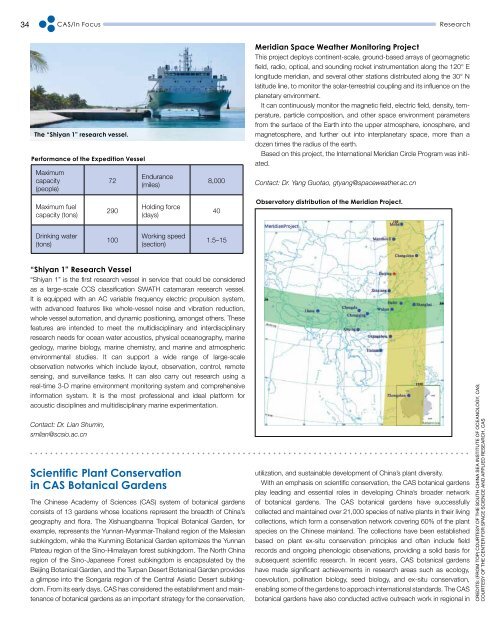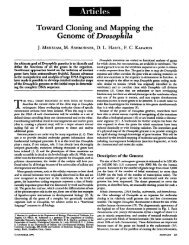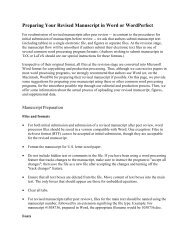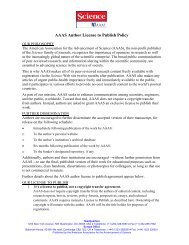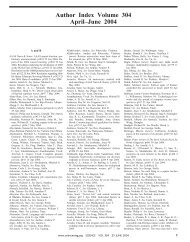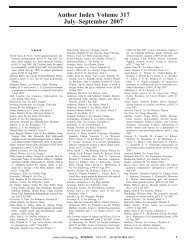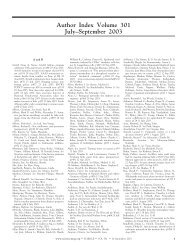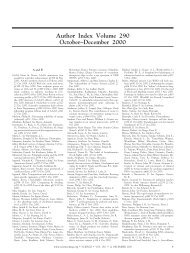Chinese Academy of Sciences (PDF) - low res version
Chinese Academy of Sciences (PDF) - low res version
Chinese Academy of Sciences (PDF) - low res version
Create successful ePaper yourself
Turn your PDF publications into a flip-book with our unique Google optimized e-Paper software.
34<br />
CAS/In Focus<br />
The “Shiyan 1” <strong>res</strong>earch vessel.<br />
Performance <strong>of</strong> the Expedition Vessel<br />
Maximum<br />
capacity<br />
(people)<br />
Maximum fuel<br />
capacity (tons)<br />
Drinking water<br />
(tons)<br />
“Shiyan 1” Research Vessel<br />
“Shiyan 1” is the first <strong>res</strong>earch vessel in service that could be considered<br />
as a large-scale CCS classification SWATH catamaran <strong>res</strong>earch vessel.<br />
It is equipped with an AC variable frequency electric propulsion system,<br />
with advanced featu<strong>res</strong> like whole-vessel noise and vibration reduction,<br />
whole vessel automation, and dynamic positioning, amongst others. These<br />
featu<strong>res</strong> are intended to meet the multidisciplinary and interdisciplinary<br />
<strong>res</strong>earch needs for ocean water acoustics, physical oceanography, marine<br />
geology, marine biology, marine chemistry, and marine and atmospheric<br />
environmental studies. It can support a wide range <strong>of</strong> large-scale<br />
observation networks which include layout, observation, control, remote<br />
sensing, and surveillance tasks. It can also carry out <strong>res</strong>earch using a<br />
real-time 3-D marine environment monitoring system and comprehensive<br />
information system. It is the most pr<strong>of</strong>essional and ideal platform for<br />
acoustic disciplines and multidisciplinary marine experimentation.<br />
Contact: Dr. Lian Shumin,<br />
smlian@scsio.ac.cn<br />
Scientific Plant Conservation<br />
in CAS Botanical Gardens<br />
72<br />
290<br />
100<br />
Endurance<br />
(miles)<br />
Holding force<br />
(days)<br />
Working speed<br />
(section)<br />
8,000<br />
The <strong>Chinese</strong> <strong>Academy</strong> <strong>of</strong> <strong>Sciences</strong> (CAS) system <strong>of</strong> botanical gardens<br />
consists <strong>of</strong> 13 gardens whose locations rep<strong>res</strong>ent the breadth <strong>of</strong> China’s<br />
geography and flora. The Xishuangbanna Tropical Botanical Garden, for<br />
example, rep<strong>res</strong>ents the Yunnan-Myanmar-Thailand region <strong>of</strong> the Malesian<br />
subkingdom, while the Kunming Botanical Garden epitomizes the Yunnan<br />
Plateau region <strong>of</strong> the Sino-Himalayan fo<strong>res</strong>t subkingdom. The North China<br />
region <strong>of</strong> the Sino-Japanese Fo<strong>res</strong>t subkingdom is encapsulated by the<br />
Beijing Botanical Garden, and the Turpan Desert Botanical Garden provides<br />
a glimpse into the Songaria region <strong>of</strong> the Central Asiatic Desert subkingdom.<br />
From its early days, CAS has considered the establishment and maintenance<br />
<strong>of</strong> botanical gardens as an important strategy for the conservation,<br />
40<br />
1.5–15<br />
Research<br />
Meridian Space Weather Monitoring Project<br />
This project deploys continent-scale, ground-based arrays <strong>of</strong> geomagnetic<br />
field, radio, optical, and sounding rocket instrumentation along the 120° E<br />
longitude meridian, and several other stations distributed along the 30° N<br />
latitude line, to monitor the solar-ter<strong>res</strong>trial coupling and its influence on the<br />
planetary environment.<br />
It can continuously monitor the magnetic field, electric field, density, temperature,<br />
particle composition, and other space environment parameters<br />
from the surface <strong>of</strong> the Earth into the upper atmosphere, ionosphere, and<br />
magnetosphere, and further out into interplanetary space, more than a<br />
dozen times the radius <strong>of</strong> the earth.<br />
Based on this project, the International Meridian Circle Program was initiated.<br />
Contact: Dr. Yang Guotao, gtyang@spaceweather.ac.cn<br />
Observatory distribution <strong>of</strong> the Meridian Project.<br />
utilization, and sustainable development <strong>of</strong> China’s plant diversity.<br />
With an emphasis on scientific conservation, the CAS botanical gardens<br />
play leading and essential roles in developing China’s broader network<br />
<strong>of</strong> botanical gardens. The CAS botanical gardens have successfully<br />
collected and maintained over 21,000 species <strong>of</strong> native plants in their living<br />
collections, which form a conservation network covering 60% <strong>of</strong> the plant<br />
species on the <strong>Chinese</strong> mainland. The collections have been established<br />
based on plant ex-situ conservation principles and <strong>of</strong>ten include field<br />
records and ongoing phenologic observations, providing a solid basis for<br />
subsequent scientific <strong>res</strong>earch. In recent years, CAS botanical gardens<br />
have made significant achievements in <strong>res</strong>earch areas such as ecology,<br />
coevolution, pollination biology, seed biology, and ex-situ conservation,<br />
enabling some <strong>of</strong> the gardens to approach international standards. The CAS<br />
botanical gardens have also conducted active outreach work in regional in<br />
CREDITS: (FROM TOP) COURTESY OF THE SOUTH CHINA SEA INSTITUTE OF OCEANOLOGY, CAS;<br />
COURTESY OF THE CENTER FOR SPACE SCIENCE AND APPLIED RESEARCH, CAS


